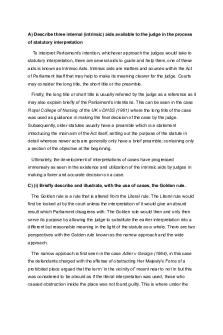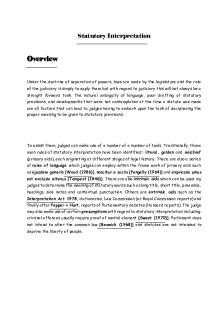Statutory Interpretation Procedure PDF

| Title | Statutory Interpretation Procedure |
|---|---|
| Author | Jin Seunghyun |
| Course | Foundations of Law |
| Institution | University of Queensland |
| Pages | 3 |
| File Size | 94.7 KB |
| File Type | |
| Total Downloads | 50 |
| Total Views | 142 |
Summary
Download Statutory Interpretation Procedure PDF
Description
How to interpret a statute 1. Determine the issue(s) with the statute e.g. Is ________ liable under _________ provision? 2. Determine the jurisdiction of the statute (Qld, Cth, etc.) - Does the Act apply here? - Pick the relevant AIA to be used in interpreting the statute (either Qld or Cth) 3. Check when the Act commences - Is it already in force? - Was it in force when the problem occurred? - Use the Qld or Cth AIA to determine when it’ll come into effect after the Royal Assent, if the actual commencement isn’t specified 4. Text-based analysis (of sections relating to issue) - Analyse to find the plain ordinary meaning of the section, which gives rise to where the ambiguity is - Look at the definitions section of the present Act, or of the relevant AIA, to find the legal meaning of the section - Start looking at canons of construction and presumptions to find legal meaning Canons of Construction: Words of similar meaning: noscitur a sociis Words take their meaning from the context in which they appear The class rule: ejusdem generis When two or more specific words are followed by a general word, the general word should be interpreted in view of the class or genus created by those specific words Express inclusions and implied exclusions: expression unius est exclusion alterius If there are certain words in a statute and other related words are left out, it must have been the intention of the Parliament to expressly include those words - Impliedly, Parliament intended to leave other words out Specific prevails over general: generalia specialibus non derogant If you have a general provision in a statute which covers particular circumstances in the issue, and you have a specific provision in that statute that appears to cover the issue and the circumstances, prefer what the specific tells you to do
Presumptions:
For QLD legislation, s14(3) of the Acts Interpretation Act 1954 (Qld) abolishes the use of common law presumptions when interpreting statutes passed after 30 June 1991. Despite this, there doesn’t seem to be a significant practical difference in approaching statutory interpretation without these presumptions. We’re not allowed to use the presumptions, but we still do the things that the presumptions describe. Legislation does not bind the crown Acts of Parliament in Australia commonly rebut this presumption by stating “This Act Binds the Crown”. Parliament is presumed not to legislate extraterritorially Presumed that Parliaments do not intend to enact legislation which has operation beyond their relevant jurisdiction. Two requirements if they do wish to: (1) Parliament must have constitutional power to do so; (2) Parliament must clearly express intention in the statute. Statutes do not operate retrospectively Presumed that laws are not to be construed as attaching new legal consequences to facts or events which occurred before commencement. Criminal and penal provisions are interpreted narrowly Presumed that criminal and penal provisions of a statute are to be interpreted narrowly in favour of the accused person. Parliament does not interfere with fundamental rights (important) Presumed that Parliament does not interfere with the fundamental and vested rights of the individual. If they DO intend to do so, it must be with unmistakeable and unambiguous language. 5. Context-based analysis - Read related sections, then Act in full to get correct context - Look at historical context of the Act (including previous versions) - Look at presumptions again 6. Purpose-based analysis - Look at the long title of the Act, the purpose clause (usually cl. 3) - Do one of the following: i) Confirm the interpretation we made from text or text and context ii) Find intention of how Parliament intended it to work in your situation iii) Use purpose to clarify, choose one interpretation over another
7. Extrinsic Material
-
Check the second reading speech, explanatory memorandum to try and determine the purpose of the Act again
8. Conclude - Summarise after looking at multiple different issues - Have one conclusion for each of the main issues analysed - Then have one big conclusion for the whole Act interpretation - State the legal meaning/ ratio
Text -> Context -> Purpose If you believe that you’ve determined the legal meaning after consideration of the text and context, it would be rare for the statutory purpose to override that legal meaning. Purpose should not override legal meaning derived through analysis in context where that legal meaning is the preferred interpretation. However, if after analysis in context the legal meaning is still unclear, it may be the purpose that gives you the answer as to whether the section applies to the issue. If you still don’t know if the section applies after discerning purpose, check extrinsic material.
Amos v Brisbane CC: Extrinsic material should not override the clear legal meaning determined through analysis in context....
Similar Free PDFs

Statutory Interpretation
- 6 Pages

Statutory Interpretation
- 6 Pages

Statutory Interpretation
- 3 Pages

Statutory Interpretation
- 5 Pages

Statutory Interpretation
- 11 Pages

Statutory Interpretation
- 6 Pages

Statutory interpretation notes
- 2 Pages

Statutory Interpretation 70102
- 5 Pages

Statutory Interpretation in Malaysia
- 12 Pages

Statutory Interpretation Notes
- 9 Pages

Statutory Interpretation Notes
- 4 Pages
Popular Institutions
- Tinajero National High School - Annex
- Politeknik Caltex Riau
- Yokohama City University
- SGT University
- University of Al-Qadisiyah
- Divine Word College of Vigan
- Techniek College Rotterdam
- Universidade de Santiago
- Universiti Teknologi MARA Cawangan Johor Kampus Pasir Gudang
- Poltekkes Kemenkes Yogyakarta
- Baguio City National High School
- Colegio san marcos
- preparatoria uno
- Centro de Bachillerato Tecnológico Industrial y de Servicios No. 107
- Dalian Maritime University
- Quang Trung Secondary School
- Colegio Tecnológico en Informática
- Corporación Regional de Educación Superior
- Grupo CEDVA
- Dar Al Uloom University
- Centro de Estudios Preuniversitarios de la Universidad Nacional de Ingeniería
- 上智大学
- Aakash International School, Nuna Majara
- San Felipe Neri Catholic School
- Kang Chiao International School - New Taipei City
- Misamis Occidental National High School
- Institución Educativa Escuela Normal Juan Ladrilleros
- Kolehiyo ng Pantukan
- Batanes State College
- Instituto Continental
- Sekolah Menengah Kejuruan Kesehatan Kaltara (Tarakan)
- Colegio de La Inmaculada Concepcion - Cebu




